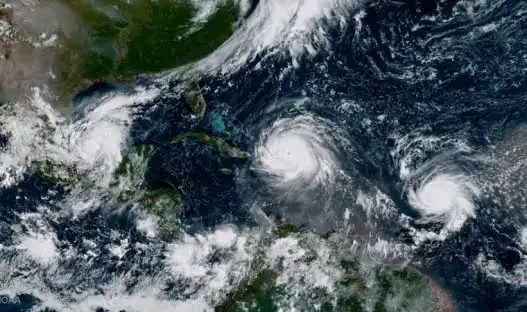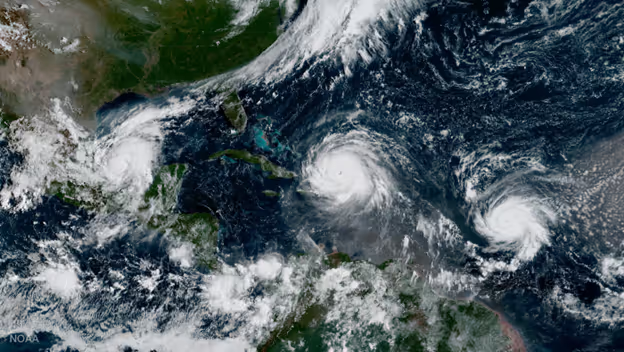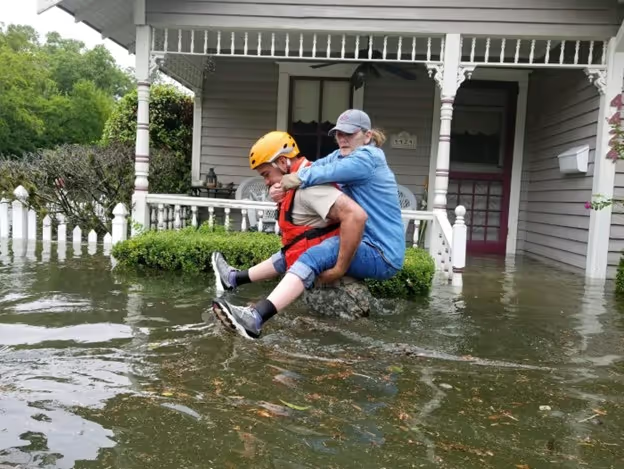
Hampered by a historical focus and other shortcomings, cat models can’t adequately quantify future risk in a rapidly changing climate. Analytics based on best-in-science climate models give insurers a far-sighted assessment of climate-driven impacts.
The new Federal Reserve request asks the largest U.S. banks to imagine their current portfolio of assets being struck by a tropical cyclone in the Northeast (and by a different peril elsewhere in the country), with and without insurance, and causing losses consistent with their estimated 100-year and 200-year return period loss in 2050.
Banks may be tempted to use catastrophe models (‘cat models’) for the exercise because they natively output event losses and incorporate insurance contracts. However, as our previous blog suggests, a pure cat modeling approach has drawbacks. Cat models are less able to accurately imagine the events of the future, because they are based on the events of the past.
Jupiter is already working with some of the largest banks in the country to take a more sophisticated approach to climate change risk assessment—one that considers its effects globally, to a broad set of perils, with methods grounded in the newest advancements from the scientific community.
Hampered by a historical focus and other shortcomings, cat models can’t adequately quantify future risk in a rapidly changing climate. Analytics based on best-in-science climate models give insurers a far-sighted assessment of climate-driven impacts.

For over thirty years, cat models (primer available here) have quantified natural disaster risk, helping re/insurers confidently underwrite and trade risk. Insurers could craft underwriting rules based on their risk tolerance, and reinsurers could diversify portfolios of Prague Flood, Gulf Coast Hurricane, Japan Earthquake, and Australia Bushfire.
But as the climate changes, our exposure to these high-impact events is growing. The cracks are starting to show. The Geneva Association recently stated: “While highly useful for today’s and next year’s portfolio management, catastrophe models are limited in providing decision-useful quantitative information over a longer term, impeding progress toward a forward-looking climate change and exposure/vulnerability landscape.” Seven-time Leading London Underwriter award winner Richard Trubshaw of MAP was more blunt in his December 2020 Managing Agent’s Report:
"The problem is, what [reinsurers] are being fed (via the counterparty’s intermediary) is risk-output from a severely under-cooked model. I find it particularly ironic that industry veterans will regularly opine on global warming and climate change…yet their organizations are still pricing to the same mis-calibrated metrics that were in place five years ago, despite the heightened catastrophic frequency since 2016, in both the Atlantic and Pacific, despite deterioration in loss estimates, despite the proliferation in wildfires in California and Australia — and that is observed reality, let alone whether the future will actually be even more extreme."
What can be done about this “under-cooked” view of present-day risk and the expected future changes? With cat models thoroughly entrenched in the insurance underwriting and risk management frameworks, it would be extremely convenient to tweak a few settings and create a “climate adjusted view of risk” that is valid for present-day and the 5- to 30-year time horizons for which boards of directors and regulators are increasingly asking. But do these tweaks truly address the short-sightedness of present-day views of risk? What is gained and lost with these methods?
Adjusting Cat Models for Climate Risk: Current Approaches
The foundation of cat models is a set of stochastic events: simulated hurricanes, earthquakes, floods, and other events. Models assign explicit frequencies to each event, and these frequencies become the basis for simulated timelines of how these events may occur over the next 1–5 years. For example, in a 10,000-year simulation of Florida hurricanes, Miami might be unscathed in 9,400 of those years, but, during the other 600 years, be struck by a mix of direct hits and glancing blows from tropical storms through major hurricanes. For each event, wind speeds, rainfall, and storm surge are simulated, damage is estimated, and the financial consequences to insurance policies and reinsurance treaties are quantified. By examining the full, 10,000-year simulation, an exceedance probability curve can be calculated.
To account for climate change, cat model vendors and users often either adjust event rates to simulate new Year Loss Tables (YLTs) or resample complete years into new YLTs. For example, they might raise the frequency of Category 5 hurricanes that strike Miami or reshuffle the YLT so that the resulting precipitation ranges match the expected trends from climate models, as RMS did in a recent European flood assessment. But this has several drawbacks:
1. It only represents the events and years that we experience today. Most importantly, it is impossible to incorporate events and simulated years unlike those we’ve seen before. Cat model events are loosely constrained by what we’ve seen in the past, but just four years ago, Hurricane Harvey announced that the storms of the future, with unprecedented rainfall, might look very different from those of today. In addition, events may cluster and compound differently in the future than they do today, which a reweighted YLT can’t capture.

2. It doesn’t incorporate broader shifts in the climate. Event rate adjustments also over-simplify how several perils may change over time. Does solely changing event frequency account for changing event intensity? Wildfire severity, for example, is significantly affected by the available fuel sources. As prolonged drought turns forests into grasslands, we can expect our fire seasons to evolve differently.
3. Limited perils and regions. Cat modelers focus their efforts on so-called Tier 1 perils and regions, which tend to drive insurance premiums. But climate change will have much broader effects. According to Swiss Re, 70% of insured losses in 2020 were from secondary peril events such as severe convective storms and wildfires. Climate change will also raise the prominence of previously overlooked perils, such as business interruption claims when a mine can’t operate in extreme temperatures or agricultural losses because laborers can’t work enough hours due to a high heat index. As insurers consider climate risk, they need to think more broadly than the most high-profile events.
4. Slow to update. Cat models are impressively intricate, but they also evolve slowly. As a result, cat models can be several years behind even when they are first released. This gap is widening as the pace of innovation in climate science accelerates, led by thousands of climate scientists who have learned to take advantage of big data and cloud computing to improve models and tease out the impacts of climate change. For example, the land cover projections that affect wildfire fuel have only appeared in Global Climate Models (GCMs) released in the last year, and there is emerging research on changing hail risk. A new paradigm is needed that is more connected to the scientific community so that insurers can benefit from all of this crucial work.
Where can climate models help?
Compared to cat modeling firms, climate modelers take a fundamentally different approach to understanding the impact of climate change on perils. The core principle is one of nonstationarity: that weather conditions, land cover, sea level, and many other factors are always changing, and they will collectively affect how events form, propagate, and intensify. Many of these changes are captured in GCMs, which are released by institutions around the world and represent the consolidated work of thousands of scientists. Starting with GCMs, as opposed to Regional Climate Models (RCMs), ensures that data and methods are equally applicable in Tier 1 countries and the developing world. (RCMs like CORDEX have their own uses and misuses, as my colleague Dr. Josh Hacker recently discussed.) Occasionally these models have exactly what we need, such as the daily max temperature for our heat metrics, but Jupiter often takes GCM output many steps further. For example, hail probabilities are not explicitly modeled, but we can build our own projections based on downscaled values of the freezing level, Convective Available Potential Energy (CAPE), and other factors. The critical thresholds that cause hail in the future are identical to those of today; it’s the weather conditions themselves that are changing.
Jupiter has moved far beyond what GCMs can offer regarding tropical cyclone risk. Tropical cyclones are poorly represented in climate models; even with dozens of ensembles from dozens of GCMs, there aren’t enough simulations to thoroughly blanket our world’s coastlines with an adequate mixture of possible tropical cyclones with realistic physical characteristics. Instead, Jupiter has layered thousands of our own tropical cyclones — with accompanying wind, rain, and surge — based on the supportive environmental conditions from GCMs. With scientific consensus about changing tropical cyclone wind and rain intensities only recently being established (Knutson et al., 2020), our next release of ClimateScore Global will change the mixture of tropical cyclones in our event set that is applied in each future year and scenario that we model. This gives us 52 distinct event sets: a historical baseline plus three scenarios for each of the 17 future year periods that we model. This fall, we’ll also incorporate emerging research on event clustering and future track migration. These innovations ensure that our customers benefit from the latest that science has to offer.
Even with this event simulation approach, our solution is not, nor is it intended to be, a fully-fledged cat model. Our partners in insurance use us to augment cat models for longer-term portfolio planning, asset management, risk management, and regulatory reporting and to identify where cat models may be “under-cooked” today. We are working to bring climate modeling and cat modeling together in a way that adheres to our core principles: climate-conditioned from the outset, nimble and swift incorporation of scientific innovations, globally applicable methods, strong verification and validation, and transparent documentation. While it may not be as convenient as tweaking event rates and recalculating an EP curve, we believe this to be a more accurate, appropriate, and defensible method to quantify climate risk.
Learn how some of the world’s banks are winning with Jupiter by requesting a demo.
Follow us on LinkedIn
Email us info@jupiterintel.com
.webp)
